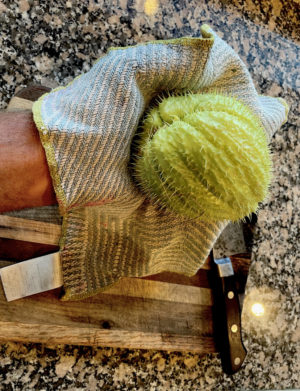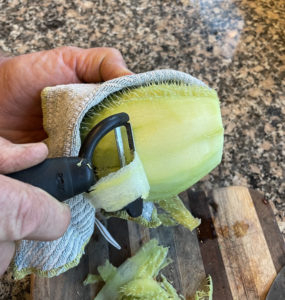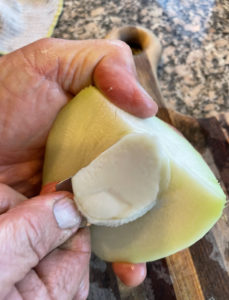Consumer Alert

You’re probably going to want a towel to protect your hand. We’re doing our first chayote harvest. Most of the chayote have spines, but some don’t. The spineless chayotes are as smooth as a baby’s butt, but the spiny ones are pretty assertive. So use the towel to pick up the chayote.
 Use a vegetable peeler to remove the spines. Even the spineless ones are best peeled so as to remove the tough hide. Chayotes are in the squash family, but they behave somewhat differently than their zucchini cousins. Once harvested, chayotes can remain happy and healthy sitting in a bowl, not even refrigerated, and the tough hide is part of their strategy. In fact, if you don’t cook your chayote up, eventually a stem will emerge from the bottom of the fruit. You could just pop it into a pot of soil and it will grow into a sprawling, vining, jungly glory in your garden. I provide a frame to control mine.
Use a vegetable peeler to remove the spines. Even the spineless ones are best peeled so as to remove the tough hide. Chayotes are in the squash family, but they behave somewhat differently than their zucchini cousins. Once harvested, chayotes can remain happy and healthy sitting in a bowl, not even refrigerated, and the tough hide is part of their strategy. In fact, if you don’t cook your chayote up, eventually a stem will emerge from the bottom of the fruit. You could just pop it into a pot of soil and it will grow into a sprawling, vining, jungly glory in your garden. I provide a frame to control mine.Once the chayote is peeled, split it down the middle. You will discover the big, fat, immature seed at the heart of the chayote, looking not unlike an avocado pit. Scoop out and discard the seed. Now you can slice the flesh into cubes. Raw, the flavor is not unlike an unripe melon- crispy and almost sweet, like a firm cucumber. You can enjoy the chayote raw in salads, but it is typically cooked. I cooked up mine as though it were zucchini, with some herbal salt, a twist of black pepper, and a squeeze of lime. It came out very nicely as a side dish. There are a lot of Mexican dishes that employ chayote, but I also ordered a chayote dish in a local Chinese restaurant recently just to try it. Because the flavor is mild it can marry with a wide range of flavors.
discover the big, fat, immature seed at the heart of the chayote, looking not unlike an avocado pit. Scoop out and discard the seed. Now you can slice the flesh into cubes. Raw, the flavor is not unlike an unripe melon- crispy and almost sweet, like a firm cucumber. You can enjoy the chayote raw in salads, but it is typically cooked. I cooked up mine as though it were zucchini, with some herbal salt, a twist of black pepper, and a squeeze of lime. It came out very nicely as a side dish. There are a lot of Mexican dishes that employ chayote, but I also ordered a chayote dish in a local Chinese restaurant recently just to try it. Because the flavor is mild it can marry with a wide range of flavors.
 discover the big, fat, immature seed at the heart of the chayote, looking not unlike an avocado pit. Scoop out and discard the seed. Now you can slice the flesh into cubes. Raw, the flavor is not unlike an unripe melon- crispy and almost sweet, like a firm cucumber. You can enjoy the chayote raw in salads, but it is typically cooked. I cooked up mine as though it were zucchini, with some herbal salt, a twist of black pepper, and a squeeze of lime. It came out very nicely as a side dish. There are a lot of Mexican dishes that employ chayote, but I also ordered a chayote dish in a local Chinese restaurant recently just to try it. Because the flavor is mild it can marry with a wide range of flavors.
discover the big, fat, immature seed at the heart of the chayote, looking not unlike an avocado pit. Scoop out and discard the seed. Now you can slice the flesh into cubes. Raw, the flavor is not unlike an unripe melon- crispy and almost sweet, like a firm cucumber. You can enjoy the chayote raw in salads, but it is typically cooked. I cooked up mine as though it were zucchini, with some herbal salt, a twist of black pepper, and a squeeze of lime. It came out very nicely as a side dish. There are a lot of Mexican dishes that employ chayote, but I also ordered a chayote dish in a local Chinese restaurant recently just to try it. Because the flavor is mild it can marry with a wide range of flavors. Chayote dishes are traditional in Mexico around the season of the Day of The Dead. The plants will yield a harvest up until the frost comes and kills the green leaves. But even when the vines die back the chayote persists underground. The plant makes a starchy tuber under the ground, much like a potato. The chayote tubers are eaten too, and I look forward to trying one out. Mostly, I’m going to leave my plants’ tubers underground so that the plants have a head start on sprouting next season. Since our planting seems to be a success I’m planning on planting a bunch more next spring. As more chayotes set on the vines this season I’ll select about 60 or so of the fattest ones and save as seedstock for next year. I read that in Mexico it is traditional to plant chayote on the 5th of February. I won’t do that. We’re so much farther north so a frost free planting date for planting will come later. I’ll plant my next crop on April Fool’s Day as the next season in farming gets rolling.
Chayote dishes are traditional in Mexico around the season of the Day of The Dead. The plants will yield a harvest up until the frost comes and kills the green leaves. But even when the vines die back the chayote persists underground. The plant makes a starchy tuber under the ground, much like a potato. The chayote tubers are eaten too, and I look forward to trying one out. Mostly, I’m going to leave my plants’ tubers underground so that the plants have a head start on sprouting next season. Since our planting seems to be a success I’m planning on planting a bunch more next spring. As more chayotes set on the vines this season I’ll select about 60 or so of the fattest ones and save as seedstock for next year. I read that in Mexico it is traditional to plant chayote on the 5th of February. I won’t do that. We’re so much farther north so a frost free planting date for planting will come later. I’ll plant my next crop on April Fool’s Day as the next season in farming gets rolling.—© 2021 Essay by Andy Griffin. Photos by Andy Griffin and Starling Linden


